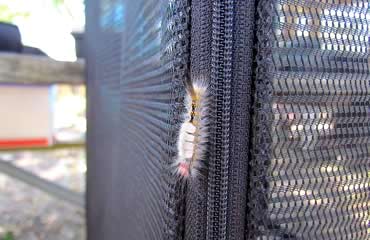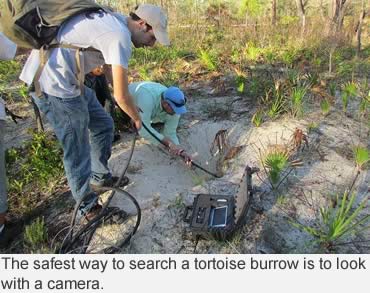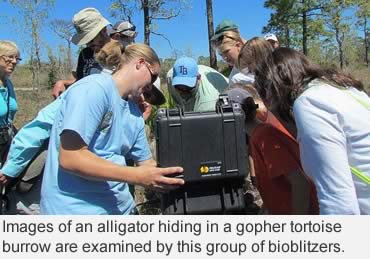What’s a bioblitz? Think of it as a wildlife adventure where you get a chance to find, identify and catalog all the plants and animals you see while exploring the outdoors.
Groups of citizen scientists of all ages, in many different areas in the United States, are reconnecting with nature in helpful and educational ways by bioblitzing.
In Florida, which is observing the 75th anniversary of the state’s Wildlife Management Area system, bioblitzing groups of adults and young people are being guided by biologists from Fish and Wildlife Conservation and counting, recording, photographing and cataloging their findings.
This year, fun and exploratory bioblitzes are happening around the state. The first was held April 1 at Chassahowitzka WMA, located in the WMA Southeast Region.
About 20 people, accompanied by FWC biologists, explored the area and looked for reptiles, amphibians, birds and insects, and they found them.
“ Many people on the Chassahowitzka WMA bioblitz were experiencing the beauty of this wild place for the first time,” said Peter Kleinhenz, who helped organize the FWC bioblitzes.
Many people on the Chassahowitzka WMA bioblitz were experiencing the beauty of this wild place for the first time,” said Peter Kleinhenz, who helped organize the FWC bioblitzes.
“The group on this trek spotted over 80 species, including an alligator hiding in a gopher tortoise burrow, and 43 plants and animals were scientifically verified based on their photos,” he said.
More bioblitzes are planned: May 6 at the Aucilla WMA; Sept. 23 at Watermelon Pond Wildlife and Environmental Area; and Oct. 21 at J.W. Corbett WMA.
Anyone can be a citizen scientist by joining a Florida WMA bioblitz. Sign up online by clicking on the calendar here.
If that doesn’t fit your schedule, or you live in a different state, you don’t need to miss out on a bioblitz, because you can go out on your own and have a similar experience.
In Florida, bioblitz participants are asked to upload their cellphone or digital camera photos of the plants, insects and animals they encounter in WMAs into the iNaturalist app.
 Biologists with iNaturalist then identify the species – sometimes within minutes or several hours, although it may take a day or longer. Sightings of Florida species are being gathered on the newly created iNaturalist platform known as the Florida Nature Trackers Program.
Biologists with iNaturalist then identify the species – sometimes within minutes or several hours, although it may take a day or longer. Sightings of Florida species are being gathered on the newly created iNaturalist platform known as the Florida Nature Trackers Program.
“Anyone joining a bioblitz and helping catalog wildlife sightings on the iNaturalist app is building a better inventory of the plants and animals living on Florida’s wildlife management areas,” Kleinhenz said. “Just imagine how this digital collection of Florida-specific wildlife data will make a difference in monitoring and conserving imperiled species and wildlife habitats.”
More than 30,000 sightings already have been submitted to Florida Nature Trackers, which went live in late February 2017.
The Florida Nature Trackers program includes a series of projects people can join. There are now 15 projects, including eight WMA projects.
One project is on the Chassahowitzka bioblitz and others are on Florida birds, mammals, herps (reptiles and amphibians), insects, spiders and plant pollinators. In the bird project, as of mid-April, more than 1,400 people had shared over 24,000 observations that included sightings of 446 species.
 Eventually each WMA where the FWC is the lead manager will have its own project on Florida Nature Trackers.
Eventually each WMA where the FWC is the lead manager will have its own project on Florida Nature Trackers.
Texas, which has used iNaturalist since 2014, has had good results, including uploads of more than 40,000 sightings of reptiles and amphibians in the state.
The iNaturalist organization is a citizen science project and online social network of naturalists, citizen scientists, and biologists. It is built on the concept of mapping and sharing observations of biodiversity across the globe.
Observations may be added via the website or from a mobile application. The free app is available for both android and apple devices. Learn more about the iNaturalist program at http://www.inaturalist.org/.
In Florida, the 75th anniversary celebration of its WMAs will be ongoing throughout 2017. Other activities include photo and geocaching contests, birding tours and volunteer days. To learn more about the anniversary projects and the nearly 6 million acres of lands in Florida’s WMA system, visit here.
— Photos courtesy of Florida Fish & Wildlife.
— Read recent Critter Tale:
Be Bear Aware this Spring